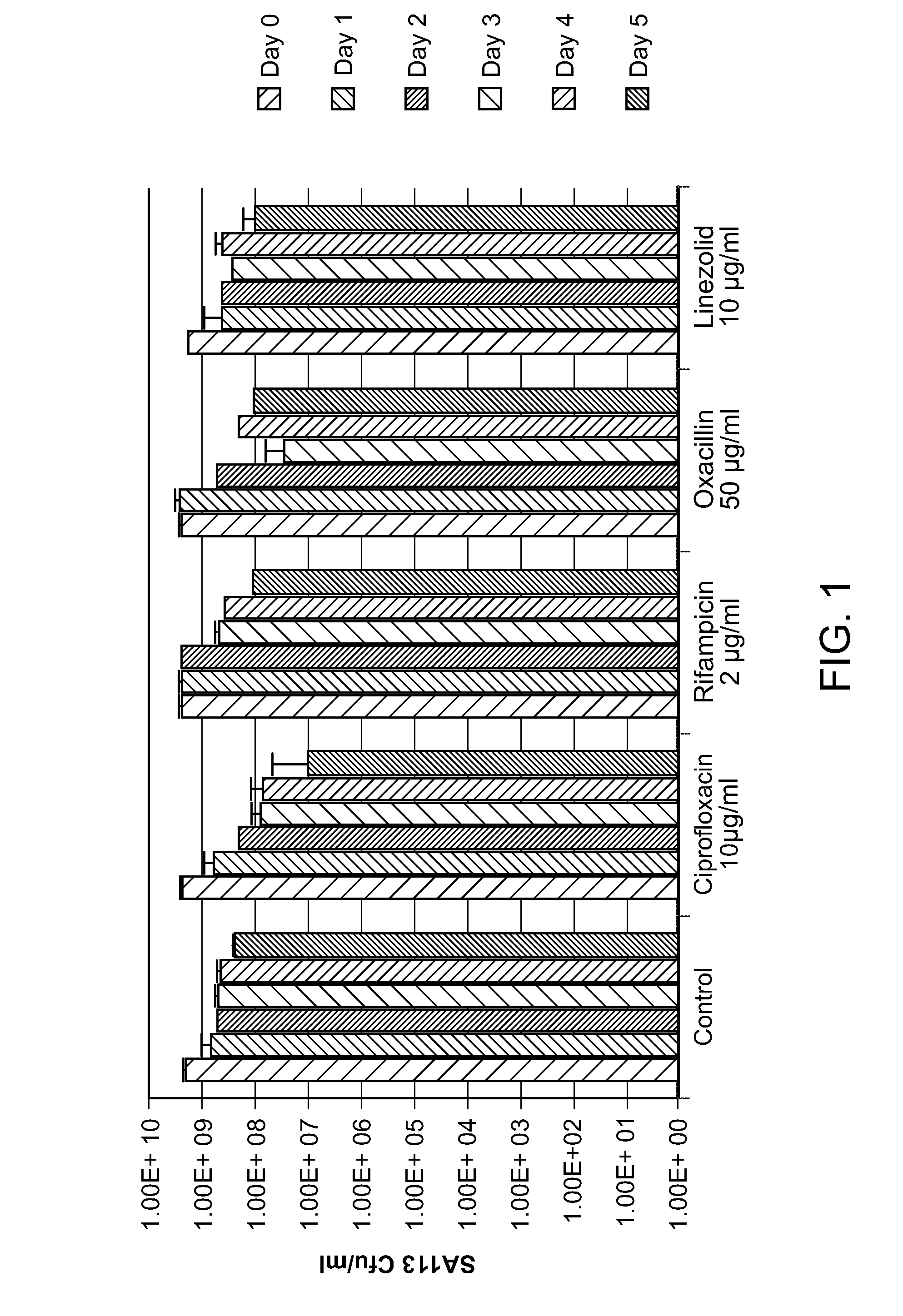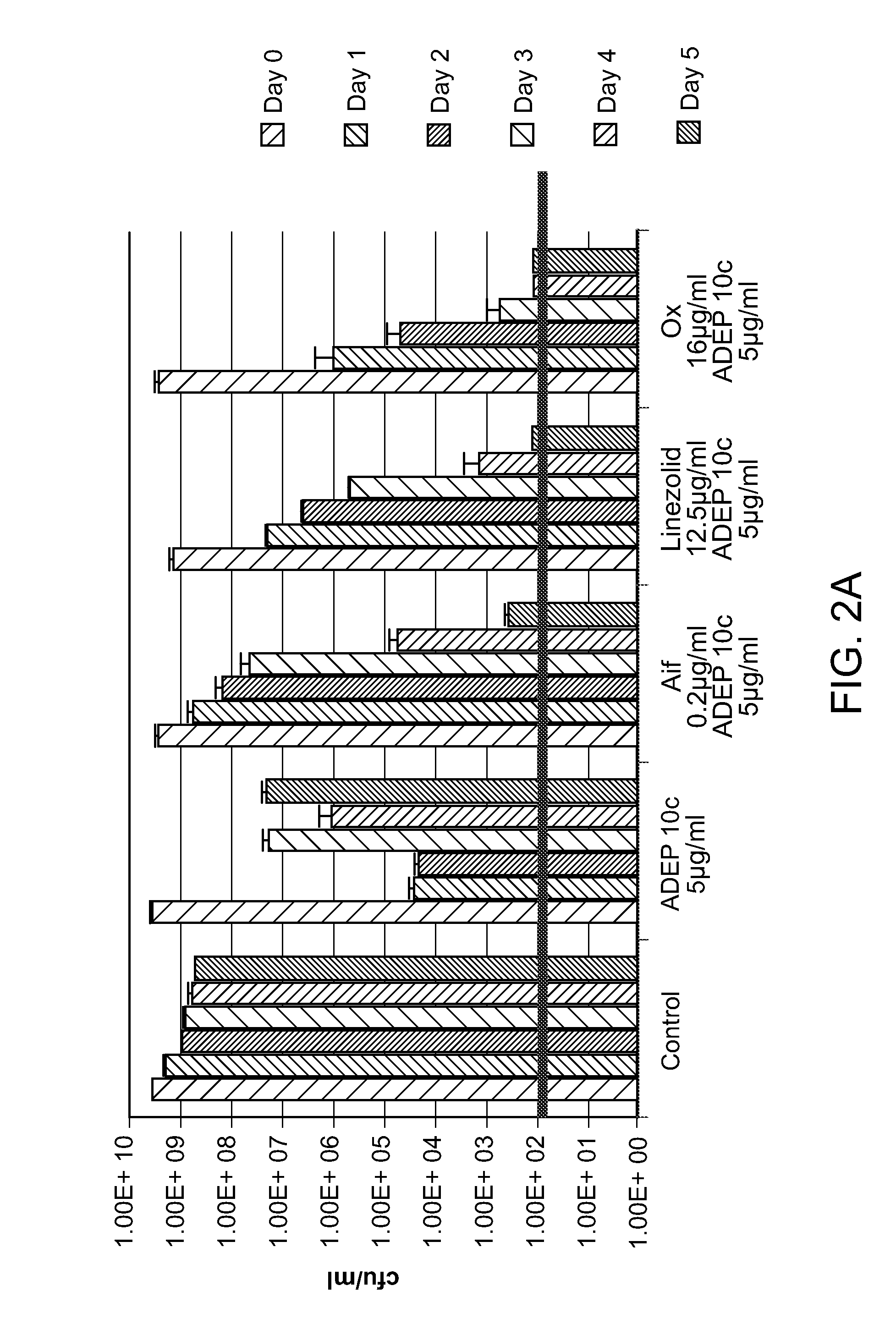Methods of eradicating bacterial cell populations
a technology of bacterial cell populations and methods, applied in the field of medicine, can solve the problems of no therapeutic capable of eradicating chronic infections, decreased treatment duration of gram-positive diseases, increased infection risk, etc., and achieve the effect of reducing the duration of treatment and increasing the risk of infection
- Summary
- Abstract
- Description
- Claims
- Application Information
AI Technical Summary
Benefits of technology
Problems solved by technology
Method used
Image
Examples
example 1
[0066]Methods of making ADEP are detailed in U.S. Pat. No. 6,858,585. Moreover, derivatives ADEP 4 and ADEP 10c can be obtained from Wuxi AppTec in St. Paul, Minn.
[0067]The activity of derivatives ADEP 10c and ADEP 4 were compared to other antimicrobials. ADEP 10c was found to have an S. aureus MIC of 5 μg / ml. ADEP 4 was found to have an MIC of 0.75 μg / ml against S. aureus. Referring to FIG. 1, antibiotic action against stationary state S. aureus. SA113, an MSSA commonly used as a S. aureus model strain, was evaluated. S. aureus SA113 was grown in Mueller-Hinton broth for 24 hours. Antibiotics were added at day 0. Time-points were taken every 24 hours. 100 μl of culture was removed, centrifuged for one minute, and the cells were resuspended in PBS. Serial dilutions from neat to 10−6 were spotted on MHA plates and incubated overnight at 37° C. The results shown in FIG. 1 are the averages of three independent experiments.
[0068]As FIG. 1 shows, bactericidal antibiotics ciprofloxacin an...
example 2
[0073]ADEP 4 has an S. aureus IC 50 of 0.05 μg / ml (Brotz-Oesterhelt, H., D. Beyer, H. P. Kroll, R. Endermann, C. Ladel, W. Schroeder, B. Hinzen, S. Raddatz, H. Paulsen, K. Henninger, J. E. Bandow, H. G. Sahl & H. Labischinski, (2005) Dysregulation of bacterial proteolytic machinery by a new class of antibiotics. Nat Med 11: 1082-1087). It was determined that MIC of ADEP 10c is 5 μg / ml, and MIC of ADEP 4 is 0.75 μg / ml when tested with a variety of MSSA and MRSA isolates. ADEP 4 at 1.5×MIC showed no killing activity against stationary S. aureus after 24 hours. However, when combined with rifampicin, ADEP 4 resulted in complete sterilization in 5 days (not shown).
example 3
[0074]Evaluation of ADEP 10c and ADEP 4 showed that ADEP 10c had a notably higher MIC than ADEP 4 compound. An activity-based SAR of ADEP compounds has been previously reported (Brotz-Oesterhelt, H., D. Beyer, H. P. Kroll, R. Endermann, C. Ladel, W. Schroeder, B. Hinzen, S. Raddatz, H. Paulsen, K. Henninger, J. E. Bandow, H. G. Sahl & H. Labischinski, (2005) Dysregulation of bacterial proteolytic machinery by a new class of antibiotics. Nat Med 11: 1082-1087). A number of analogs were examined herein to obtain an SAR that informs not only potency but also killing ability.
[0075]Analogs that show the superior eradicating activity while retaining good potency, MIC≦1 μg / ml, are good candidates for development. Approximately 40 derivatives of the natural products enopeptin A or B have been described and assessed for their antibacterial activity (Brotz-Oesterhelt, H., D. Beyer, H. P. Kroll, R. Endermann, C. Ladel, W. Schroeder, B. Hinzen, S. Raddatz, H. Paulsen, K. Henninger, J. E. Bandow...
PUM
| Property | Measurement | Unit |
|---|---|---|
| Time | aaaaa | aaaaa |
| Density | aaaaa | aaaaa |
| Density | aaaaa | aaaaa |
Abstract
Description
Claims
Application Information
 Login to View More
Login to View More - R&D
- Intellectual Property
- Life Sciences
- Materials
- Tech Scout
- Unparalleled Data Quality
- Higher Quality Content
- 60% Fewer Hallucinations
Browse by: Latest US Patents, China's latest patents, Technical Efficacy Thesaurus, Application Domain, Technology Topic, Popular Technical Reports.
© 2025 PatSnap. All rights reserved.Legal|Privacy policy|Modern Slavery Act Transparency Statement|Sitemap|About US| Contact US: help@patsnap.com



